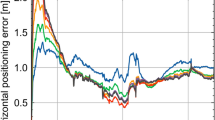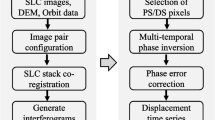Abstract
The identification of single and multiple-point emission sources from limited number of atmospheric concentration measurements is addressed using least square data assimilation technique. During the process, a new two-step algorithm is proposed for optimization, free from initialization and filtering singular regions in a natural way. Source intensities are expressed in terms of their locations reducing the degree of freedom of unknowns to be estimated. In addition, a strategy is suggested for reducing the computational time associated with the multiple-point source identification. The methodology is evaluated with the synthetic, pseudo-real and noisy set of measurements for two and three simultaneous point emissions. With the synthetic data, algorithm estimates the source parameters exactly same as the prescribed in all the cases. With the pseudo-real data, two and three point release locations are retrieved with an average error of 17 m and intensities are estimated on an average within a factor of 2. Finally, the advantages and limitations of the proposed methodology are discussed.



Similar content being viewed by others
References
Ayres, F. Jr., Schaum’s Outline of Theory and Problems of Matrices, (Schaum, New York 1962), 219 pp.
Beyer, W.A. (1964), A Note on Starting the Newton-Raphson Method, Communications of the ACM (CACM) 7, 442 pp.
Bocquet, M. (2005a), Reconstruction of an atmospheric tracer source using the principle of maximum entropy-I: Theory, Q. J. R. Meteorol. Soc. 131, 2191–2208.
Bocquet, M. (2005b), Reconstruction of an atmospheric tracer source using the principle of maximum entropy-II: Applications, Q. J. R. Meteorol. Soc. 131, 2209–2223.
Cohn, S.E. (1997), An introduction to estimation theory, J. of the Met. Soc. of Japan 75, 1B, 257–288.
Debye, P. (1909), Näherungsformeln für die Zylinderfunktionen für große Werte des Arguments und unbeschränkt veränderliche Werte des Index, Mathematische Annalen 67(4), 535–558.
Elbern H., Strunk A. Schmidt H., Talagrand O. (2007), Emission rate and chemical state estimation by 4-dimensional variational inversion, Atmos. Chem. Phys. 7, 3749–3769.
Golub, G.H. and Vanloan, C.F., Matrix computations, (Johns Hopkins University Press, Baltimore 1996), 694 pp.
Haupt, S.E. (2005), A demonstration of coupled receptor/dispersion modelling with a genetic algorithm, Atmos. Environ. 39, 7181–7189.
Hestenes, M.R. and Stiefel, E. (1952), Methods of Conjugate Gradients for Solving Linear Systems, Journal of Research of the National Bureau of Standards 49, 409–436.
Issartel, J.-P., Baverel, J. (2002), Adjoint backtracking for the verification of the Comprehensive Nuclear Test Ban Treaty, Atmospheric Chemistry and Physics Discussions 2, 2133–2150.
Issartel, J.P., Sharan, M. and Modani, M. (2007), An inversion technique to retrieve the source of a tracer with an application to synthetic satellite measurements, Proc. R. Soc. A 463, 2863–2886.
Issartel, J.P., Sharan, M. and Singh S.K. (2011), A retrieval technique for multiple point emissions from atmospheric concentration measurements, Submitted for publication.
Keats, A., Yee, E. and Lien, F.S. (2007a), Bayesian inference for source determination with applications to a complex urban environment, Atmos. Environ. 41, 465–479.
Keats, A., Yee, E. and Lien, F.S. (2007b), Efficiently characterizing the origin and decay rate of a nonconservative scalar using probability theory, Ecological Modelling 205, 437–452.
Krysta, M., Bocquet, M., Sportisse, B. and Isnard, O. (2006), Data assimilation for short-range dispersion of radionuclides: An application to wind tunnel data, Atmos. Environ. 40, 7267–7279.
Levenberg, K. (1944), A Method for the Solution of Certain Non-Linear Problems in Least Squares, The Quarterly of Applied Mathematics 2, 164–168.
Lewis, J.M., Lakshmivarahan, S. and Dhall S.K., Dynamic Data Assimilation: A Least Square Approach, (Cambridge University Press, 2006), 654 pp.
Liu, X. and Zhai, Z. (2007), Inverse modeling methods for indoor airborne pollutant tracking: literature review and fundamentals, Indoor Air 17, 419–438.
Lushi, E. and Stockie, J.M. (2010), An inverse Gaussian plume approach for estimating atmospheric pollutant emissions from multiple point sources, Atmos. Environ. 44, 1097–1107.
Marchuk, G.I., Adjoint equations and analysis of complex systems, (Kluver Academic Publishers, Dordrecht, 1995).
Marquardt, D. (1963), An Algorithm for Least-Squares Estimation of Nonlinear Parameters, SIAM Journal on Applied Mathematics 11, 431–441.
Matthes, J., Gröll, L. and Keller, H.B. (2005), Source localization by spatially distributed electronic noses for advection and diffusion, IEEE Trans. Signal Process 53, 1711–1719.
Penenko, V., Baklanov, A. and Tsvetova, E. (2002), Methods of sensitivity theory and inverse modelling for estimation of source term. Future Generation Computer Systems 18, 661–671.
Pudykiewicz, J.A. (1998), Application of adjoint tracer transport equations for evaluating source parameters, Atmos. Environ. 32, 3039–3050.
Rao, K.S. (2007), Source estimation methods for atmospheric dispersion, Atmos. Environ. 41, 6964–6973.
Robertson, L. and Langner, J. (1998), Source function estimate by means of variational data assimilation applied to the ETEX-I tracer experiment, Atmos. Environ. 32, 4219–4225.
Sharan, M., Issartel, J.P., Singh, S. K. and Kumar, P. (2009), An inversion technique for the retrieval of single-point emissions from atmospheric concentration measurements, Proc. R. Soc. A 465, 2069–2088.
Sharan, M., Issartel, J.P. and Singh, S. K. (2011), A point-source reconstruction from concentration measurements in low wind stable conditions, Submitted for publication.
Sharan, M., Singh, M.P., Yadav, A.K., Aggarwal, P. and Nigam, S. (1996), A mathematical model for the dispersion of pollutants in low wind conditions, Atmos. Environ. 30, 1209–1220.
Singh, M.P., Agarwal, P., Nigam, S. and Gulati, A. (1991), Tracer experiments—a report. Technical report, Centre for Atmospheric Science, IIT Delhi.
Yee, E. (2005), Probabilistic inference: an application to the inverse problem of source function estimation, The Technical Cooperation Program (TTCP) Chemical and Biological Defence (CBD) Group Technical Panel 9 (TP-9) Annual Meeting, Defence Science and Technology Organization, Melbourne, Australia.
Yee, E. (2006), A Bayesian approach for reconstruction of the characteristics of a localized pollutant source from a small number of concentration measurements obtained by spatially distributed “electronic noses”, Russian-Canadian Workshop on Modeling of Atmospheric Dispersion of Weapon Agents, Karpov Institute of Physical Chemistry, Moscow, Russia.
Yee, E. (2007), Bayesian probabilistic approach for inverse source determination from limited and noisy chemical or biological sensor concentration measurements, Chemical and Biological Sensing VIII (Augustus W. Fountain III, ed), Proc of SPIE 6554, 12 pp.
Yee, E. (2008), Theory for Reconstruction of an Unknown Number of Contaminant Sources using Probabilistic Inference, Boundary-Layer Meteorology 127, 359–394.
Yee, E., Lien, F.S., Keats, A., Hseih, K.J. and D’Amours, R. (2006), Validation of Bayesian inference for emission source distribution using the Joint Urban 2003 and European Tracer Experimnents, Fourth International Symposium on Computational Wind Engineering (CWE2006), Yokohama, Japan, 4 pp.
Author information
Authors and Affiliations
Corresponding author
Rights and permissions
About this article
Cite this article
Sharan, M., Singh, S.K. & Issartel, J.P. Least Square Data Assimilation for Identification of the Point Source Emissions. Pure Appl. Geophys. 169, 483–497 (2012). https://doi.org/10.1007/s00024-011-0382-3
Received:
Accepted:
Published:
Issue Date:
DOI: https://doi.org/10.1007/s00024-011-0382-3




